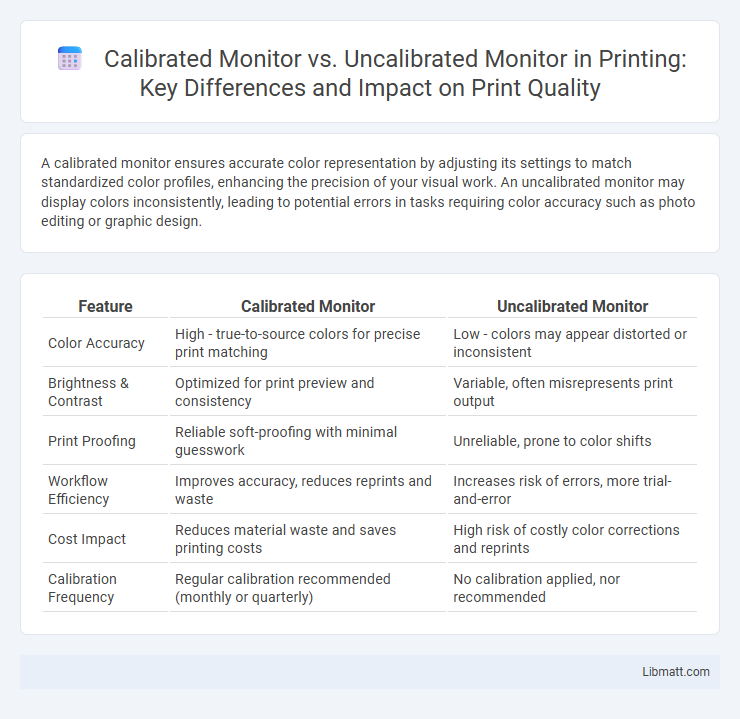A calibrated monitor ensures accurate color representation by adjusting its settings to match standardized color profiles, enhancing the precision of your visual work. An uncalibrated monitor may display colors inconsistently, leading to potential errors in tasks requiring color accuracy such as photo editing or graphic design.
Table of Comparison
| Feature | Calibrated Monitor | Uncalibrated Monitor |
|---|---|---|
| Color Accuracy | High - true-to-source colors for precise print matching | Low - colors may appear distorted or inconsistent |
| Brightness & Contrast | Optimized for print preview and consistency | Variable, often misrepresents print output |
| Print Proofing | Reliable soft-proofing with minimal guesswork | Unreliable, prone to color shifts |
| Workflow Efficiency | Improves accuracy, reduces reprints and waste | Increases risk of errors, more trial-and-error |
| Cost Impact | Reduces material waste and saves printing costs | High risk of costly color corrections and reprints |
| Calibration Frequency | Regular calibration recommended (monthly or quarterly) | No calibration applied, nor recommended |
Definition of Calibrated vs Uncalibrated Monitors
A calibrated monitor is one that has been adjusted to display colors, brightness, and contrast accurately according to industry standards, ensuring consistent and true-to-life visuals. An uncalibrated monitor lacks these adjustments, often resulting in inaccurate color representation and inconsistent display quality. Your work, especially in color-sensitive tasks like photo editing or design, benefits greatly from using a calibrated monitor to maintain visual precision and reliability.
Importance of Monitor Calibration
Monitor calibration ensures accurate color representation, essential for graphic design, photo editing, and video production where color precision impacts final output quality. An uncalibrated monitor may display inconsistent hues, brightness, and contrast, leading to errors and wasted time in correcting colors later. By calibrating your monitor, you achieve consistent, true-to-life visuals that improve workflow efficiency and meet industry standards.
Color Accuracy Differences
Calibrated monitors deliver precise color accuracy by aligning with standardized color profiles, ensuring consistent and true-to-life color representation across different devices. Uncalibrated monitors often exhibit color shifts, incorrect gamma, and varying white points, leading to inconsistent and inaccurate colors. Professional fields such as photography, graphic design, and video editing rely on calibrated monitors to maintain color fidelity and produce reliable visual outputs.
Impact on Professional Workflows
A calibrated monitor ensures accurate color reproduction, crucial for professional workflows in graphic design, photography, and video editing. Your work's consistency and quality rely on precise color representation, which uncalibrated monitors often fail to provide, leading to misaligned prints or digital outputs. Investing in calibration tools or software enhances workflow efficiency by reducing time spent on color correction and client revisions.
Visual Consistency Across Devices
Calibrated monitors ensure visual consistency across devices by standardizing color profiles, gamma, and brightness, which leads to accurate and predictable color reproduction. Uncalibrated monitors often show significant color discrepancies, brightness variations, and contrast shifts, causing inconsistent visual experiences in collaborative workflows or multi-device setups. Accurate calibration supports color management systems essential for industries like photography, design, and video production, where uniformity across screens is critical.
User Experience and Eye Strain
A calibrated monitor ensures accurate color representation and consistent brightness, significantly enhancing your user experience by reducing eye strain and preventing visual fatigue during extended screen time. An uncalibrated monitor often displays inaccurate colors and uneven brightness, which can cause eye discomfort and increased strain as your eyes constantly adjust to inconsistencies. Choosing a calibrated monitor supports healthier vision and more comfortable viewing, especially for tasks requiring color precision and prolonged use.
Calibration Tools and Techniques
Calibration tools such as colorimeters and spectrophotometers are essential for achieving accurate color representation on a calibrated monitor, ensuring consistency across devices. Software-based techniques adjust color profiles, brightness, contrast, and gamma settings to match industry standards like sRGB or AdobeRGB. Your workflow benefits significantly when using these tools and techniques, resulting in precise color accuracy and improved image quality during editing or design tasks.
Cost Implications and Value
Calibrated monitors often incur higher upfront costs due to specialized hardware and software requirements, but they deliver accurate color representation essential for professional design, photography, and video production, ultimately enhancing workflow efficiency and output quality. Uncalibrated monitors are typically less expensive initially but may lead to inconsistent color accuracy, causing potential rework and color correction expenses that impact overall project budget and value. Investing in a calibrated monitor provides long-term cost savings by reducing errors and ensuring color fidelity, which is critical for brands and creatives prioritizing precise visual communication.
Common Misconceptions About Calibration
Many users assume uncalibrated monitors display colors accurately without verification, but this leads to inconsistent color reproduction across devices. Calibration adjusts color temperature, gamma, and brightness to industry standards, ensuring precise color matching critical for photo editing and graphic design. Neglecting calibration often results in color shifts and inaccurate tones that compromise visual projects and print outputs.
Which Monitor Type is Right for You?
Choosing between a calibrated and uncalibrated monitor depends on your specific needs and usage. Calibrated monitors provide accurate color representation essential for professional photo editing, graphic design, and video production, ensuring consistent results across devices. Uncalibrated monitors are sufficient for general use, such as web browsing and office work, where color precision is less critical.
calibrated monitor vs uncalibrated monitor Infographic

 libmatt.com
libmatt.com